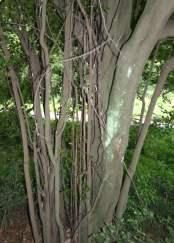Cryptocarya woodii
Cryptocarya woodii Engl.
Family: Lauraceae
Common names: Cape laurel, Cape Quince, bastard camphor tree (E): rooikweper,Kaapse kweper (A); isithungwa, inqayana, ixobothi (Xhosa) umngcabe, umnqayane, isililandangulube (Zulu)
SA Tree No: 116
Introduction
This is a handsome tree for small gardens with a lovely shape when properly pruned. The shiny, purple-black fleshy fruits are showy and complemented by the evergreen glossy leaves.

Description
Description
This is a small to medium size tree usually 5 to 10 m in height, but it can grow to 20m. in favourable conditions. The leaves are smallish shiny bright green above and slightly paler green below. They have light coloured veins that are well developed, the drip tip is well pronounced.

Cryptocarya woodii flowers in November with small inconspicuous flowers. These small flowers develop into round, shiny, purple-black fruits. This tree has a very hard brown wood.
Distribution and habitat
Distribution description
This tree is widely distributed from the Eastern Cape, the former Transkei, Kwa-Zulu Natal and Swaziland to the eastern side of Gauteng and further north on the eastern side of the continent. It is in abundant in coastal and mountainous forests, in forest kloofs, on forest fringes, in wooded valley and in dense bush. These tend to be well-watered habitats.
Derivation of name and historical aspects
History
Name derivation and historical aspects The genus word Cryptocarya is from a Greek word krypto- meaning to hide, karya- meaning a walnut tree, the fruit of which was known as karyon, a word also used to other fruits. The specific epithet of this plant was named in honour of John Medley Wood who was a botanist in Kwa-Zulu Natal. This genus has about 350 species, represented by 7 species in Southern Africa.
Ecology
Ecology
Butterfly species, Charaxes xiphanes, Papilio euphranor breed on the foliage of the Cape quince.
Uses
Use
Cryptocarya woodii is said to be used as traditional medicine for magical and medicinal purposes. Cryptocarya species are sometimes used as substitutes for Ocotea bullata. An infusion of the powdered bark is used as remedy for diarrhoea.

Growing Cryptocarya woodii
Grow
This tree is grown from seed and cuttings. Seed should be collected when the fruit is ripe. It is cleaned to remove fleshy part. Seed is sown in sandy loam soil mix in a seed tray. Seed should be covered with bark. The tray should be kept moist in a warm place. Germination should take 4 to 6 weeks.
Cryptocarya woodii is also propagated from cuttings in summer. Dip the end of the cutting in a rooting hormone powder for hard wood to promote rooting. Place cuttings in a bark and polystyrene mix.
References
- Elsa Pooley, 1993. A complete field guide to Trees of Natal, Zululand and Transkei, Natal Flora Publication Trust, Pietermaritzburg
- E. Palmer & M. Pitman, 1972, Trees of Southern Africa, A A Balkema, Cape Town
- A Leistner, 2000, Seed Plants of Southern Africa, Families & Genera, NBI, Pretoria
- Ben-Erik Van Wyk, Bosch Van Oudtshoorn, Nigel Gericke. 1997, Medicinal Plants of South Africa, Briza Publication, Pretoria
- A Hutchings, 1996, Zulu medicinal Plants, An Inventory, University of Natal Press, Pietermaritzburg,
Credits
Giles Mbambezeli
Kirstenbosch NBG
December 2005
Plant Attributes:
Plant Type: Tree
SA Distribution: Eastern Cape, KwaZulu-Natal, Mpumalanga
Soil type:
Flowering season: Early Summer
PH:
Flower colour:
Aspect:
Gardening skill: Average
Special Features:
Horticultural zones









Rate this article
Article well written and informative
Rate this plant
Is this an interesting plant?
Login to add your Comment
Back to topNot registered yet? Click here to register.